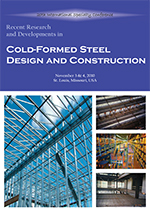Session Dates
03 Nov 2010
Abstract
The extension of the American Iron and Steel Institute’s Direct Strength Method (DSM) to cold-formed steel beams with holes is nearly in place. DSM was first introduced to th e AISI specification in 2004 as an alternative to the effective width met hod, and is widely considered a major advancement in cold-formed steel component design. In DSM, the beam elastic buckling properties for a general cross-section are obtained with a computer analysis utilizing the finite strip method. A disadvantage of the finite strip method and DSM has been that discrete holes along the member length could not be easily accounted for, although the recent development of simplified elastic buckling approximations including holes has now alleviated the inherent shortcoming. This paper provides an introduction to the DSM approach for cold- formed steel beams with holes, where th e critical elastic buckling moments for local, distortional, and global buckling are calculated including the presence of holes, and then input into strength prediction expressions modified to capture the strength reduction from yielding at the net section. A DSM design example of a joist with evenly spaced web holes is provided.
Department(s)
Civil, Architectural and Environmental Engineering
Research Center/Lab(s)
Wei-Wen Yu Center for Cold-Formed Steel Structures
Meeting Name
20th International Specialty Conference on Cold-Formed Steel Structures
Publisher
Missouri University of Science and Technology
Document Version
Final Version
Rights
© 2010 Missouri University of Science and Technology, All rights reserved.
Document Type
Article - Conference proceedings
File Type
text
Language
English
Recommended Citation
Moen, Christopher D. and Schafer, Benjamin W., "Extending Direct Strength Design to Cold-formed Steel Beams with Holes" (2010). CCFSS Proceedings of International Specialty Conference on Cold-Formed Steel Structures (1971 - 2018). 4.
https://scholarsmine.mst.edu/isccss/20iccfss/20iccfss-session5/4
Extending Direct Strength Design to Cold-formed Steel Beams with Holes
The extension of the American Iron and Steel Institute’s Direct Strength Method (DSM) to cold-formed steel beams with holes is nearly in place. DSM was first introduced to th e AISI specification in 2004 as an alternative to the effective width met hod, and is widely considered a major advancement in cold-formed steel component design. In DSM, the beam elastic buckling properties for a general cross-section are obtained with a computer analysis utilizing the finite strip method. A disadvantage of the finite strip method and DSM has been that discrete holes along the member length could not be easily accounted for, although the recent development of simplified elastic buckling approximations including holes has now alleviated the inherent shortcoming. This paper provides an introduction to the DSM approach for cold- formed steel beams with holes, where th e critical elastic buckling moments for local, distortional, and global buckling are calculated including the presence of holes, and then input into strength prediction expressions modified to capture the strength reduction from yielding at the net section. A DSM design example of a joist with evenly spaced web holes is provided.



